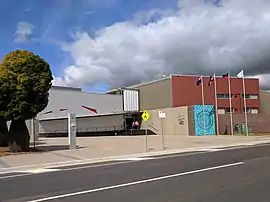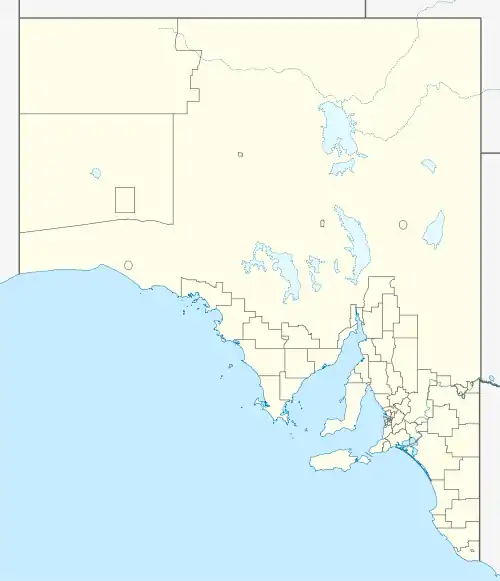City of Elizabeth
The City of Elizabeth was a local government area located in the northern suburbs of Adelaide and seated at Elizabeth from 1964 to 1997.
| City of Elizabeth South Australia | |||||||||||||||
|---|---|---|---|---|---|---|---|---|---|---|---|---|---|---|---|
 City of Playford civic centre in 2017, formerly the City of Elizabeth council seat | |||||||||||||||
 City of Elizabeth | |||||||||||||||
| Coordinates | 34°42′54″S 138°40′12″E | ||||||||||||||
| Established | 1964 | ||||||||||||||
| Abolished | 1997 | ||||||||||||||
| Council seat | Elizabeth | ||||||||||||||
| |||||||||||||||
History
Prior to the 1950s, most of the area surrounding today's suburb of Elizabeth was farming estates. After the end of the Second World War and the accompanying shortage of materials, the state government decided that South Australia needed to grow and become an industrialised state.
A satellite city was planned for northern metropolitan fringe of Adelaide, and the South Australian Housing Trust initiated a housing development program in the area, with a purchase of 3,000 acres (1,200 ha) of rural land between the established townships of Salisbury and Smithfield.
Elizabeth, the suburb, was established within the District Council of Salisbury on 16 November 1955,[1] being named after Queen Elizabeth II, who visited the city in 1963. More than seven years later, the Salisbury council was renamed to be the District Council of Salisbury and Elizabeth in 1963 in recognition of the burgeoning community on its northern lands. A year later, on 1 July 1964, the municipality of the Town of Elizabeth was created by severance from the District Council of Salisbury and Elizabeth,[2] and the latter reverted to the name Salisbury.
The new municipality encompassed most or all of the suburbs of Elizabeth North, to the north, Elizabeth Park, to the north east, Elizabeth East, to the east, Elizabeth Grove and Elizabeth Vale, to the south east, Elizabeth South, to the south and south west, and Elizabeth West (now most of Edinburgh North and the southern half of Davoren Park), to the north west.
The City of Elizabeth was amalgamated with the City of Munno Para in 1997 to form the City of Playford.[3] Twenty years hence, the term 'Elizabeth', in the context of Adelaide, still typically referred to the pre-amalgamation municipality encompassing both the suburb of Elizabeth and those suburbs surrounding it, and the distinct community they comprised.[4]
A total of nine suburban localities clustered around the Elizabeth town centre were named for the City of Elizabeth, by which they were locally governed at some point:
- Elizabeth South
- Elizabeth North
- Elizabeth East
- Elizabeth West (abolished in 2011 and split between Edinburgh North and Davoren Park)
- Elizabeth Downs
- Elizabeth Field (abolished in 1993; now Davoren Park)[5]
- Elizabeth Grove
- Elizabeth Park
- Elizabeth Vale
Community
The early town centre, now Elizabeth Shopping Centre, had open air shopping malls and a theatre called the Octagon.[6] Residential suburbs of Elizabeth were established with the earliest being Elizabeth South and Elizabeth North. Each was configured as a local community around a small shopping centre containing a supermarket, bank, hotel and service station along with other shops. Automotive manufacturer Holden established a manufacturing plant in the area, becoming a major employer along with the Department of Defence with its Long Range Weapons Establishment, later the Defence Science and Technology Organisation, and RAAF Base Edinburgh. Migrants were encouraged to settle in Elizabeth and its suburbs.
Elizabeth had large areas of open space, with the most prominent being Fremont Park, on Main North Road. Elizabeth was the sister city of Fremont, California;[7] Lake Elizabeth in Fremont Central Park is named for the city.
Elizabeth also had a strong music scene, providing a home for Jimmy Barnes,[8][9][10] John Swan,[11] Bernard "Doc" Neeson and Glenn Shorrock,[12] among other musicians.
Mayors of Elizabeth
- Eugene Francis O'Sullivan (1964-1965) [13]
- Stewart Lynn Gilchrist (1965-1968) [13]
- Lloyd Maxwell Duffield (1968-1972) [13]
- Joyce Eastland (1972-1977) [13]
- Terry Hemmings (1977-1979) [13]
- Eve Edge (1979-1980) [13]
- Donald Paginton (1980-1981) [13]
- Martyn Evans (1981-1984) [13][14]
- Alfred (Alf) Thomas Charles (1989-1995) [15]
- Marilyn Baker (1995-1997) [16]
Neighbouring local government
The following adjacent local government bodies co-existed with the Elizabeth council:
- District Council of Munno Para (established 1853) lay north west, north, north east and east. In 1988 the population passed the threshold for city status and it was then known as the City of Munno Para.
- District Council of Tea Tree Gully (established 1858) lay south east. In 1968 the population passed the threshold for city status and it was then known as the City of Tea Tree Gully.
- City of Salisbury (established 1933) lay south, south west and west.
References
- "E" (PDF). Place Names of South Australia. State Library of South Australia. p. 11. Retrieved 9 August 2017.
On 16 November 1955, at a site on the Adelaide Plain, 17 miles north of Adelaide, a new town was inaugurated by Sir Thomas Playford, GCMG, Premier of South Australia
- "Local Government Act, 193401963: Portion of District Council of Salisbury and Elizabeth Severed and the Municipality of the Town of Elizabeth Constituted" (PDF). South Australian Government Gazette (7 ed.). Government of South Australia. 13 February 1964. p. 269. Retrieved 2 August 2017.
- "Thursday, 13 February 1997" (PDF). The Government Gazette of South Australia. Government of South Australia. Retrieved 22 November 2016.
- Odenwalder, Lee (6 July 2017). "Elizabeth". Hansard. Parliament of South Australia. Archived from the original on 5 August 2017. Retrieved 4 August 2017.
We have to be mindful about what we are talking about when we say Elizabeth. We are not so much talking about the existing physical suburb; indeed, Elizabeth proper these days means the few square kilometres around the Elizabeth City Centre. It has been subsumed physically and administratively by the City of Playford and by the unbroken urban sprawl which extends to the small green belt before you get to Gawler. For anyone who grew up in Elizabeth and anyone who has lived in Elizabeth for a long time, there is a very distinct physical and psychological place called Elizabeth. It is not Salisbury, it is not Munno Para, and for a lot of people it is not even the City of Playford, whose borders spread far beyond what anyone understands to be Elizabeth. For those of us who grew up there, and for those of us who live there, it is very clear where Elizabeth is. It is in many ways hard to define, but it is culturally different from other parts of the metropolitan area.
- "Search result for 'Elizabeth Field, SUB'". Property Location Browser. Government of South Australia. SA0022272. Retrieved 28 August 2017.
Current Name: Davoren Park; Other Details: Renamed in 1993 together with portion of Elizabeth West.
- "Ariel rocks the Octagon". Treasures of the State Library. State Library of South Australia. 1973.
The Octagon Theatre Elizabeth was a multi-use auditorium specially designed for a wide range of activities. Built by the City of Elizabeth, it was completed in August 1965 and was a centre for live entertainment for the central and northern suburbs of Adelaide until it was closed in January 2003. The floorboards from the theatre were refurbished and used in the Great Hall of the City of Playford's new Civic Centre which opened in March 2004.
- "Central Park (Lake Elizabeth)". City of Fremont. Retrieved 3 July 2009.
- "My plea to South Australians". The Advertiser. 26 April 2008.
- "Jimmy Barnes", ABC Television: Enough Rope, Australian Broadcasting Corporation, 11 October 2004, archived from the original on 5 September 2017, retrieved 2 August 2017,
Elizabeth is a satellite city outside of Adelaide where they just stick all the immigrants. And like I said, it was a great place when you were young, getting there, football fields everywhere, but actually as soon as you get to around 13 or 14, it gets pretty rugged, you know? There's lots of gangs, lots of street fights - like a lot of working-class places, hasn't got a lot for kids to do.
- "Jimmy Barnes", ABC Television: Talking Heads, 24 March 2008, archived from the original on 12 July 2016, retrieved 2 August 2017,
I grew up in Elizabeth, on the outskirts of Adelaide. Which, for a kid, it was a pretty good life. I mean, coming from Glasgow, where there was hardly any trees, and then suddenly getting to Elizabeth, with lots of open fields and trees and birds and football fields everywhere. Ah, we had a ball, we had a really good time. [...] Growing up in Elizabeth, even before Reg came along, it was a wild place, but a great place for kids, Elizabeth. But when you became teenagers, there was nothing to do. So basically we got involved in gangs. There was lots of street fighting, and really all the sort of trouble you could get yourself into, was available there in Elizabeth. [...] I grew up in Elizabeth, There was a lot of Scots, a lot of Poms, we were very proud of our Scottish heritage. We had a lot of very close Scottish friends. I was in the pipe band.
- "John Swan", ABC Television: Enough Rope, Australian Broadcasting Corporation, 10 December 2007
- Thompson, Peter (17 May 2010). "Glenn Shorrock transcript". ABC Television: Talking Heads. Australian Broadcasting Corporation. Archived from the original on 5 March 2011. Retrieved 14 July 2010.
- Matthews, Penny (1986), South Australia, the civic record, 1836-1986, Wakefield Press, p. 149, ISBN 978-0-949268-82-2
- "Mr Martyn Evans". Parliament of Australia. Retrieved 12 June 2016.
- "Former Mayor of Elizabeth dies". 23 November 2011. Retrieved 9 June 2016.
- "Profile of Regional Leaders" (PDF). Department of Primary Industries and Regions, Government of South Australia. Retrieved 9 June 2016.